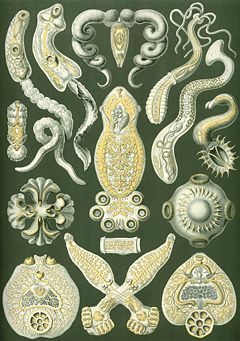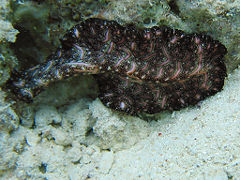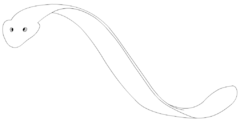Flatworm
| Flatworms | ||||
|---|---|---|---|---|
 "Platodes" from Ernst Haeckel's Kunstformen der Natur, 1909) | ||||
| Scientific classification | ||||
| ||||
| Classes | ||||
|
Monogenea |
The flatworms (Platyhelminthes, Greek "platy"': flat; "helminth": worm) are a phylum of relatively simple soft-bodied invertebrate animals. With about 25,000 known species they are the largest phylum of acoelomates. Flatworms are found in marine, freshwater, and even damp terrestrial environments. A troublesome terrestrial example is the New Zealand flatworm, Arthurdendyus triangulatus, which rapidly colonized large areas of Ireland and Scotland since its unintentional introduction in the 1960s and has since destroyed most of the indigenous earthworms.[citation needed] Most flatworms are free-living forms, but many are parasitic on other animals. There are four classes: Trematoda (Flukes), Cestoda (Tapeworms), Monogenea, and Turbellaria.
Description
The flatworm’s cephalized soft body is ribbon-shaped, flattened dorso-ventrally (from top to bottom), and bilaterally symmetric. Flatworms are the simplest triploblastic animals with organs. This means their organ systems form out of three germ layers: an outer ectoderm and an inner endoderm with a mesoderm between them. Turbellarians generally have a ciliated epidermis, while cestodes and trematodes are covered with a cuticle.
Body functions
There is also no true body cavity (coelom) except the gut and hence they are acoelomates. The interior of the acoelomate body is filled with somewhat loosely spaced mesodermal tissue called parenchyma tissue. There is no true circulatory or respiratory system, but like all other animals, flatworms do take in oxygen. Extracellular body fluids (interstitial fluids) percolate between cells to help distribute nutrients, gases, and waste products.
Flatworms respire at their integument; gasses diffuse directly across their moist outer surface. This type of system is called integumentary exchange.
However, flatworms do have a bilateral nervous system; they are the simplest animals to have one. Two cordlike nerves branch repeatedly in an array resembling a ladder. The head end of some species even has a collection of ganglia acting as a rudimentary brain to integrate signals from sensory organs such as eyespots.
Usually the digestive tract has one opening, so the animal can't feed, digest, and eliminate undigested particles of food simultaneously, as most animals with tubular guts can. This blind-ended gastrovascular cavity functions similarly to that of the Cnidaria. However, in a few particularly long flatworms or those with highly branched guts, there may be one or more anuses. A small group where the gut is absent or non-permanent, called acoel flatworms, appear to be unrelated to the other Platyhelminthes (see below).
Despite the simplicity of the digestive chamber, they are significantly more complex than cnidarians in that they possess numerous organs, and are therefore said to show an organ level of organization. Mesoderm allows for the development of these organs, and true muscle. Major sense organs are concentrated in the front end of the animals for species who possess these organs.
Muscular contraction in the upper end of the gut causes a strong sucking force allowing flatworms to ingest their food and tear it into small bits. The gut is branched and extends throughout the body, functioning in both digestion and transport of food. Flatworms exhibit an undulating form of locomotion.
Flatworm reproduction is hermaphroditic, meaning each individual produces eggs and sperm. When two flatworms mate, they exchange sperm so both become fertilized. Some flatworms, such as Pseudobiceros hancockanus engage in penis fencing, in which two individuals fight, trying to pierce the skin of the other with their penises. The first to succeed inseminates the other, which must then carry and nourish the eggs.[1] They usually do not fertilize their own eggs. Turbellarians classified as planarians (usually freshwater, non-parasitic) can also reproduce asexually by transverse fission. The body constricts at the midsection, and the posterior end grips a substrate. After a few hours of tugging, the body rips apart at the constriction. Each half grows replacements of the missing pieces to form two whole flatworms. This also means that if one of these flatworms is cut in half, each half will regenerate into two separate fully-functioning flatworms.
Depending on species and age, individuals can range in size from almost microscopic to over 20 m long (some tapeworms can attain this length).
Classes
Flatworms were formerly considered to be basal among the protostomes. Molecular evidence suggests that this is only true of the orders Acoela and Nemertodermatida, which are thus given their own phylum Acoelomorpha. These findings, however, still remain controversial. The true flatworms form a monophyletic group that developed from more complex ancestors, and grouped with several other phyla as the Platyzoa. The traditional classifications of flatworms is primarily based on differing degrees of parasitism and divided into three monophyletic classes:
- Trematoda - Flukes, probably paraphyletic to Cestoda.
- Cestoda - Tapeworms
- Monogenea - Ectoparasitic flukes with simpler life cycles than Trematode flukes. They live an exclusively parasitic existence.
The remaining flatworms are grouped together for convenience as the class Turbellaria, now comprising the following orders:
- Catenulida
- Macrostomida
- Lecithoepitheliata
- Rhabdocoela
- Prolecithophora
- Proseriata
- Tricladida
- Polycladida
Most of these groups include free-living forms. The flukes and tapeworms, though, are parasitic, and a few cause massive damage to humans and other animals.
Biochemical Memory?
In 1955 Thompson and Mconnell conditioned planarian flatworms by pairing a bright light with an electric shock. After repeating this several times they took away the electric shock, and only exposed them to the bright light. The flatworms would react to the bright light as if they had been shocked. Thompson and McConnell found that if they cut the worm in two, and allowed both worms to regenerate each half would develop the light-shock reaction. In 1962 Mconnell repeated the experiment, but instead of cutting the trained flatworms in two he ground them into small pieces and fed them to other flatworms. Incredibility these flatworms learned to associate the bright light with a shock much faster than flatworms who has not been fed trained worms. This experiment showed that memory could perhaps be transferred chemically. The experiment was repeated with mice, fish and rats, but it always failed to produce the same results. An explanation for this phenomenon in flatworms is still unknown today.[citation needed]
ReferencesISBN links support NWE through referral fees
- Campbell, Neil A., Biology: Fourth Edition (Benjamin/Cummings Publishing, New York; 1996; page 599) ISBN 0-8053-1957-3
- Crawley, John L., and Kent M. Van De Graff. (editors); A Photographic Atlas for the Zoology Laboratory: Fourth Edition) (Morton Publishing Company; Colorado; 2002) ISBN 0-89582-613-5
- Naganuma, Kenneth H. (PhD) ; Lab handout "Acoelomate Flatworms, Phylum Platyhelminthes", handed out in Fall 1997 (adapted GNU Free Documentation Licensed text: Permission granted in February 2005).
- The Columbia Electronic Encyclopedia, 6th ed. (Columbia University Press; 2004) [Retrieved 8 Feb 2005][2]
- Evers, Christine A., Lisa Starr. Biology:Concepts and Applications. 6th ed. United States:Thomson, 2006. ISBN 0-534-46224-3.
- Kentridge, Bob, "Investigations of the cellular bases of memory" [http://www.dur.ac.uk/robert.kentridge/bpp2mem1.html}
External links
- Marine flatworms of the world.
- Flatworm page on The Sea Slug Forum.
- Shape Of Life Video about Flatworms
- Imogine Lateotentare A New Species of Flatworm (Jan 21, 2006)
- Flatworms
Credits
New World Encyclopedia writers and editors rewrote and completed the Wikipedia article in accordance with New World Encyclopedia standards. This article abides by terms of the Creative Commons CC-by-sa 3.0 License (CC-by-sa), which may be used and disseminated with proper attribution. Credit is due under the terms of this license that can reference both the New World Encyclopedia contributors and the selfless volunteer contributors of the Wikimedia Foundation. To cite this article click here for a list of acceptable citing formats.The history of earlier contributions by wikipedians is accessible to researchers here:
The history of this article since it was imported to New World Encyclopedia:
Note: Some restrictions may apply to use of individual images which are separately licensed.

